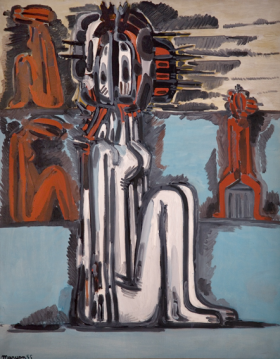Maryan
Maryan’s short life (1927-1977) was marked by tragedy. A Polish Jew, he was captured and tortured by the Nazis. He was the only member of his family to survive, narrowly escaping death in a concentration camp. He was awarded a scholarship to study in Israel and took classes at the Bezalel Art Institute in Jerusalem from 1948 to 1949. During his time in Israel, he was seriously injured in a tram accident in Tel Aviv, losing a leg.
Maryan held his first solo exhibition at the Jerusalem YMCA in 1949. He moved to Paris in 1950, spending three years at the Ecole des Beaux-Arts. Although he enjoyed some success, winning the Prix des Critiques at the Paris Biennale in 1959, and despite his role in launching the Nouvelle Figuration movement, he moved to New York in 1962. He became an American citizen in 1969 and died in 1977.
Perhaps contrary to expectations, Maryan did not focus his creative energy on documenting the terror and tragedy of the Nazi concentration camps. Having survived hell on earth, he became the divine creator of his own universe – a Human Comedy in paintings, filled with extraordinary creatures. Using screaming colours and twisting the lines almost to the limits of caricature, he categorised both figures of power (soldiers, judges, and churchmen) and those on the fringes of society (bullfighters, jugglers, and prostitutes). In this popular, carnivalesque world, Maryan no doubt aimed to create a deeply humanist message; his artistic vocabulary seems to warn us that the gap separating the victim and the torturer is infinitely narrow. The audience are thereby reminded of their free will and invited to scrutinise themselves in a mirror.
Maryan’s highly personal, deeply violent style influenced countless artists of the following generation, including Philip Guston, to name just one example. Yet despite his far-reaching influence, and for reasons that remain unclear, his oeuvre as a whole has received far less attention than it deserves.
As a youth, Maryan was sent to a concentration camp. Between shadow and light, ink and blood, he built a body of work which goes directly to the core of things with a drive, a forceful, feverish sensitivity. Considered rightfully as a forefather of New Representational art, Maryan sparks off a blaze of color, an inner search of the vital fluids that nourishes him.
